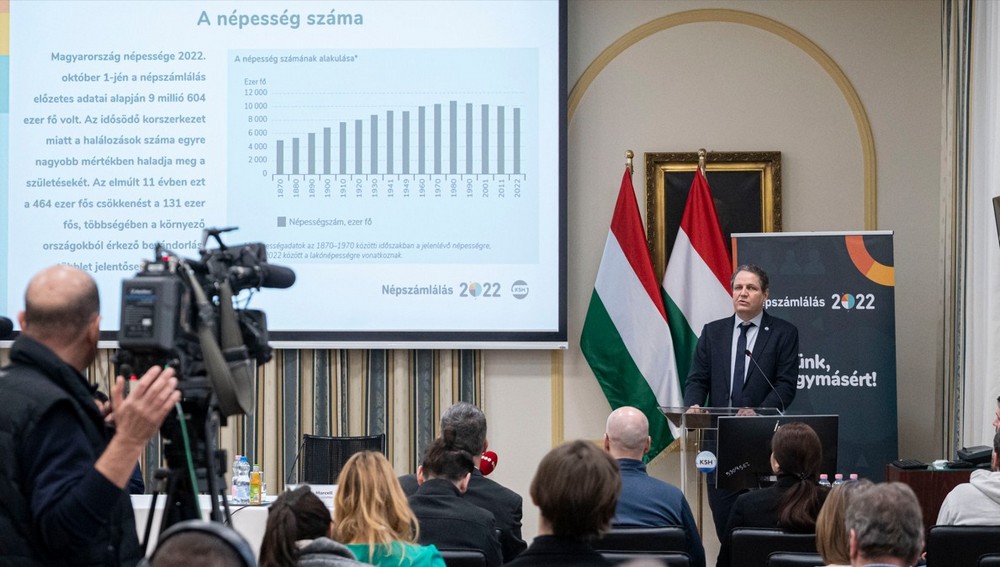According to the 2022 census, the population of Hungary has decreased to 9 million 604 thousand, all of this with the fact that a significant number of Hungarians living abroad also settled in the motherland, mainly after the adoption of dual citizenship. And where would we be without family-friendly government policies?
At the beginning of the last census, on October 1, 2022, the population of Hungary was 9,604,000 and there were 4,593,000 dwellings in the country, said Marcell Kovács, project manager of the census, at a press conference on Thursday in Budapest.
Marcell Kovács said at the first data presentation held 80 days after the end of the census: on the first of October, 4 million 613 thousand men, 4 million 491 thousand women and 1 million 407 thousand children lived in the country, the number of active age groups - between 15 and 64 years - was 6 million 201 thousand, and that of the elderly, i.e. over 65, was 1,995,000.
Between the last census of 2011 and 2022, the population decreased by 464,000 due to natural weight loss. added by the project manager.
Kovács Marcell stated that in 1870, at the time of the first census, the country had just over five million inhabitants, which - apart from wartime periods - continued to grow, rising to 10,907,000 in 1980, but since then the population has continued to decline, as more and more elderly people man, and more and more people are dying because of it. This is a phenomenon of natural weight loss, he noted.
The year 2011 was the lowest point
In the last 11 years, the number of births and deaths fluctuated, the year 2011 was the lowest point in the birth statistics, but then there was a significant increase until 2021. The total fertility rate - which shows how many children a woman would give birth to during her lifetime if she had the same chance of giving birth in a given year as a woman of the same age gave birth in the year under review - went from 1.23 in 2011 to now 1 rose above .5, which is a significant increase based on the fact that there are fewer and fewer women of childbearing age, said the project manager.
According to Marcell Kovács, the number of deaths was around 130,000 per year in the last 11 years, but there was a significant increase due to the coronavirus epidemic, the number of deaths rose to 141,000 in 2020 and 156,000 in 2021.
At last year's census, 21 percent of the population was elderly, and 15 percent were children. In the time between the two censuses, the number and proportion of the elderly increased by 318,000, or 19 percent, while the group of children decreased slightly and the group of active age decreased significantly.
The population increased in the counties of Pest and Győr-Moson-Sopron
According to territorial distribution, the population increased only in the counties of Pest and Győr-Moson-Sopron, it decreased everywhere else, the largest increase was 10 percent in the county of Pest, and the largest decrease, 13 percent, was in the county of Békés.
The change is mainly due to natural weight loss, which was the smallest in the counties of Szabolcs-Szatmár-Bereg and Pest, and the largest in the county of Békés.
Most of them moved to the county of Pest and moved from the county of Borsod-Abaúj-Zemplén. The rate of population decline was the smallest in the villages, a quarter as much as in the cities with county rights.
The most densely populated region of the country is Budapest, and among the counties Pest, Komárom-Esztergom and Győr-Moson-Sopron, the least populated county is Somogy, where there are a quarter as many people per square kilometer as in Pest county. 18 percent of the population lives in Budapest.
Since 2011, the housing stock has increased by 4.6 percent
Kovács Marcell, presenting the housing data, said that since 2011, the housing stock has increased by 4.6 percent, with the exception of Békés county, it has increased everywhere, in Transdanubia counties to a greater extent than in the eastern part of the country, the largest increase was in Győr-Moson-Sopron, Pest, and Somogy counties. The housing stock increased the most in rural towns, while it barely changed in villages.
The project leader recalled that during the first stage of the census, the population could fill out the questionnaires independently on the Internet for 19 days, and 7 million personal questionnaires were received in this form, and this number exceeded all their expectations and is a very good result in international comparison.
After that, enumerators visited households for a month, so another 2.2 million personal questionnaires were received, and during the one-week supplemental census, another 63,000 questionnaires were filled in at the local mayor's offices, which corresponds to the population of a city the size of Sopron, added the project manager. .
A total of 9.2 million personal questionnaires were collected, and the data was compared with the state databases, thus establishing that Hungary's population was 9.6 million on the first of October, Marcell Kovács pointed out.
In the future, instead of the participation of the population, the census will be conducted entirely with the help of state databases
Gabriella Vukovich, the president of the Central Statistical Office (KSH), said that in the 155-year history of the office, the snapshot was created for the 16th time, which presents the country, the population, the diversity of society, housing conditions, and family and household conditions.
This was the first completely electronic census, and due to this, as well as the use of state databases, the processing is faster, the president pointed out.
Gabriella Vukovich also said that in the future, instead of the participation of the population, the census will be conducted entirely with the help of state databases, and thanks to this, they will be able to report facts more often instead of the previous data collection every ten years.
At the end of the press conference, Kovács Marcell presented the KSH's new census database, the trial version of which can be tried with the 2011 data at http://go.ksh.hu/222.
MTI
Cover image: MTI/Zsolt Szigetváry













